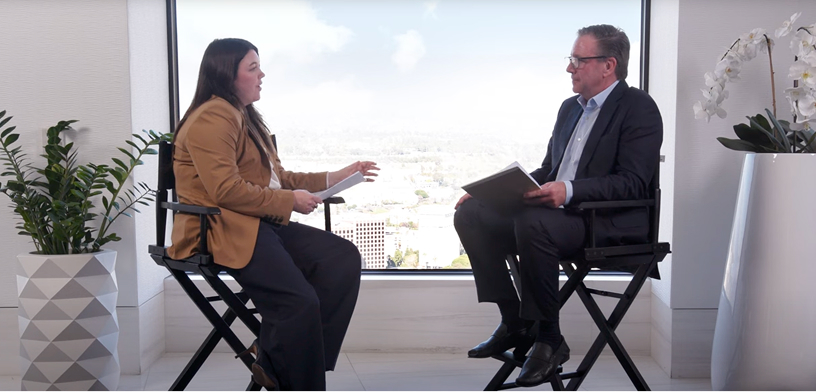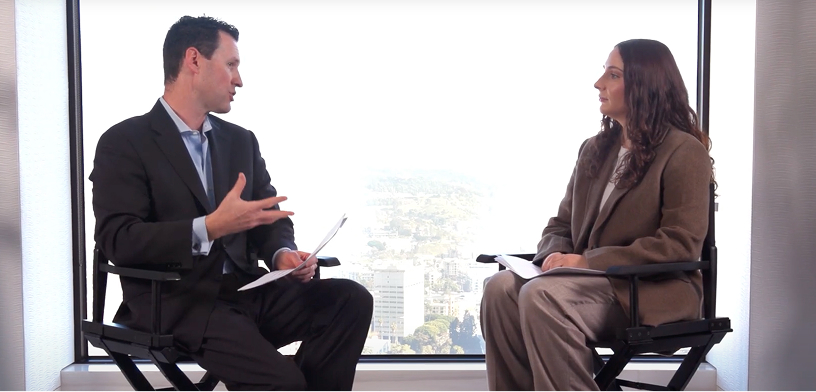In Conversation: A New Interest Rate Environment
After a historic rate hiking cycle, a new set of economic uncertainties faces the Fed’s efforts to balance economic growth and tame inflation. In the latest installment of In Conversation, ARA’s Eric Cannon and Britteni Lupe discuss what this means for commercial real estate and where investors can find opportunities in a higher interest rate environment.
Eric Cannon: Hello and welcome to another segment of ARA in Conversation. I’m Eric Cannon, Portfolio Manager of ARA’s Value Added Strategy, and I’m very pleased to be joined here today in Los Angeles by Britteni Lupe from our Research and Strategy Group. I wanted to have a conversation with you today about a subject top of mind to investors in private real estate asset class today, and that is interest rates.
We’ve just gone through an interesting few years, it’s fair to say. We had an unprecedented rate height cycle, 11 increases in the Fed Funds Rate, 525 basis points, in an effort to tame inflation. And we’re sitting here now where we’ve experienced several rate cuts. Most recently, the Fed paused, and it seems like expectations for future rate cuts are moderating.
So what is your outlook for interest rates?
Britteni Lupe: Yes, that’s a great question. We do believe that interest rates are likely to see more easing coming, but we don’t think that that’s going to be as dramatic as some might hope, or even as much as the market was pricing in early last year. In January, the Fed, they put the pause button on rate hikes, and so to us, that signals that they’re not really in a rush. And they even cited some of the same concerns that we have at ARA, which is that there’s still an ongoing threat that inflation could reaccelerate, especially given some of those embedded inflationary pressures and some of the economic policies of this current administration.
And so while we do believe that it’s likely that interest rates are gradually going to come down, ultimately we do believe that they’re going to settle at a baseline that’s relatively higher than we saw last cycle. We’re not going to go back to those ultra-low rates that we saw pre-pandemic. We’re in a new environment and the new norm is elevated rates.
EC: So with the new normal being higher for longer, what would that mean for the private real estate asset class?
BL: Higher rates are already changing the commercial real estate landscape. I mean, for one, they’ve already changed the total return threshold that investors are willing to accept.
But not only that – investors, they’re not chasing those ultra-low cap rate deals the same way they were in that low-rate environment. And I mean, frankly, why would they, when the 10-year bond is yielding higher. But with that being said, it is important to note that commercial real estate is not a bond with a fixed coupon, and what’s driving those higher yields on the treasury and the long term is an expectation of higher inflation, and that’s driven by an expectation for stronger economic growth. And that Eric right there, that is a good net positive for commercial real estate’s demand and its associated cash flows.
I don’t think that we’re going to see a reacceleration of the rent growth that we saw in 2021 or 2022, but commercial real estate, it’s still well positioned to offer competitive total returns, and we’re already seeing some positive notes for investors today. I mean, for one, they can expect higher current income returns today than they could at the end of last cycle.
And then two, we’re starting to see a lot of conviction on where rates are, and that’s giving us a lot more conviction to transact. It’s thawing out the market that was kind of frozen for 18-plus months. And the more transactions that occur, the more data we get, which firms up valuations, and then that will give conviction to even more transaction activity.
But you know, what are you thinking, as the head of our value add fund? What do you think about the feasibility of penciling certain projects and getting those value-add returns in this higher environment?
EC: Well, I would make a distinction between acquisitions and development-oriented investments. I think frankly moving forward, it’s going to be much easier for us to make acquisitions in this environment as compared to the post-COVID boom of ultra-low interest rates, a lot of leverage available at those low rates.
It was difficult for us to compete back then. We’ve always been a lower leverage investor, so we’re in a better competitive position moving forward to acquire assets. You know, back in those overheated ultra-low rate days, we pivoted and focused more on development oriented investments. That was a period of time where existing acquisitions were trading at, in some cases, 30 to 40 percent above replacement costs. So we developed industrial and multifamily properties.
If you look at development today and think about the economics of it, it’s more challenging. We have seen land costs remain elevated. Inflation has certainly filtered into construction materials costs, as well as labor costs in the marketplace, and we don’t see those materials declining in the near term. And so, while there could be selective development opportunities, we’re heavily focused right now on acquisitions. The other thing that the substantial increase in interest rates has done in the marketplace is, it has rendered a lot of owners upside down in terms of their capital stacks, so there is a good pipeline of recapitalization, restructuring, or just outright loan maturity driven acquisition opportunities in the market.
BL: Now that you’ve mentioned it, I want to stay on the topic of distress for a moment. So over the past few years, a lot of capital has been earmarked to distress, but so far that’s been relatively benign.
I actually saw a stat by RCA the other day that said that while the total balance of distressed properties is still growing, the rate of that growth has slowed down. And in fact, the net change in distress, so the number of new distress deals minus those that have been worked out, that is declining over the past 5, 6, 7 quarters.
So Eric, do you think that this distress story is a bit overblown?
EC: Well, Brittany, while it is true that the wave of distress hasn’t materialized as expected, a so-called floodgate, that’s not to say that there aren’t opportunities, and I think the story is very much still playing out. If you look at data from MSCI as of the third quarter of 2024, there was actually in excess of $100 billion of actual distress.
Those are lender REO properties that have already been taken back, or loans that are already in default. And while the office sector does comprise a majority of those overall distressed properties, there’s actually about 35 percent of them that were comprised of multifamily or retail properties, and the amount of potential distress, those are sub performing loans that may be nearing a maturity and cannot be refinanced in today’s higher rate environment, that was more than double that $100 billion. So, we do think there’s a good pipeline of opportunities. They may not be out in the public, but there’s a lot happening behind the scenes on a privately negotiated, quiet basis. We’ve been in this business for over 35 years. We know how to invest in downturns and in a period of uncertainty.
Our value-add strategy really commenced its investing in the depths of the GFC in 2009. So we expect to be very busy.
This transcript of the ARA In Conversation discussion has been edited for clarity.


